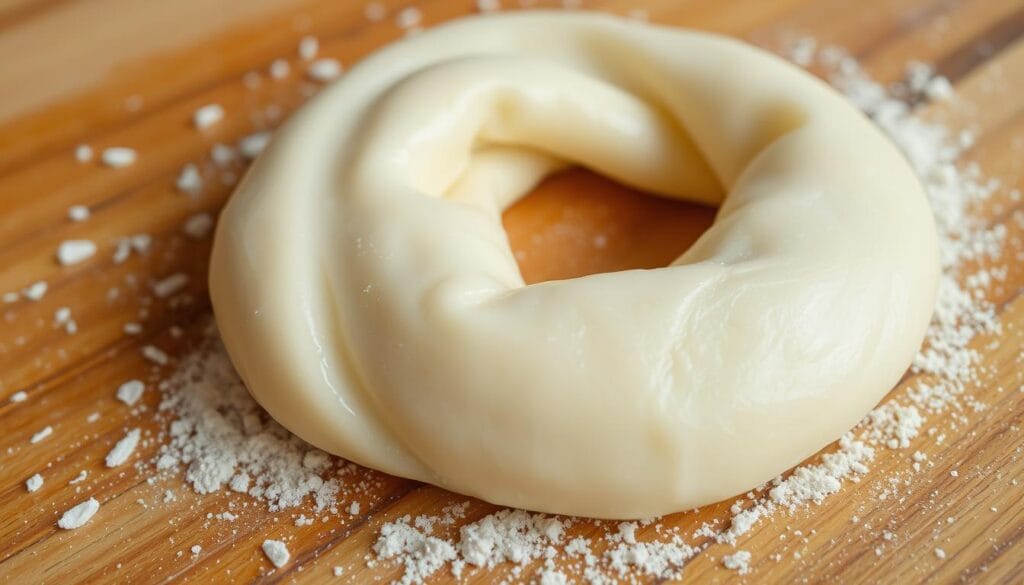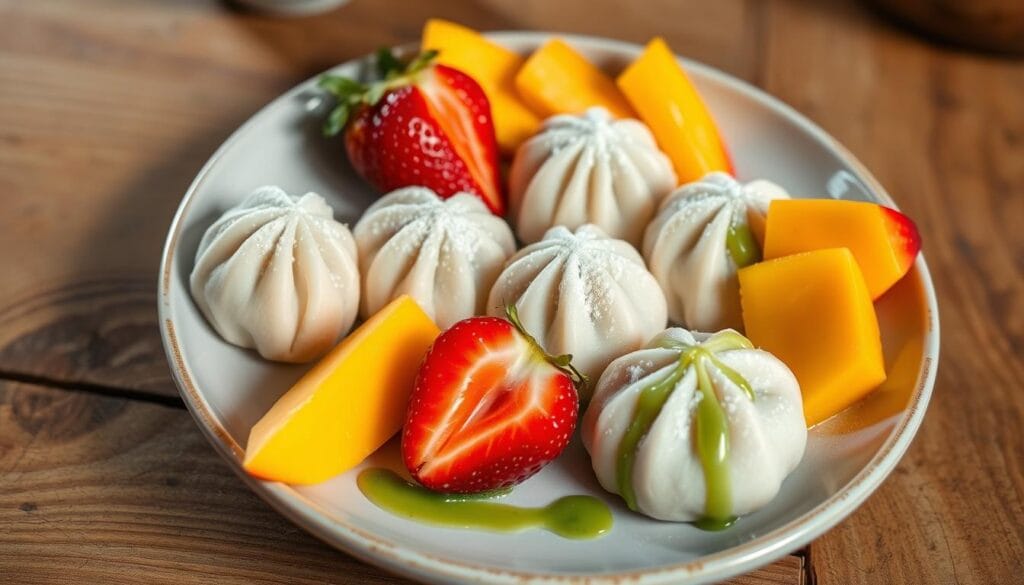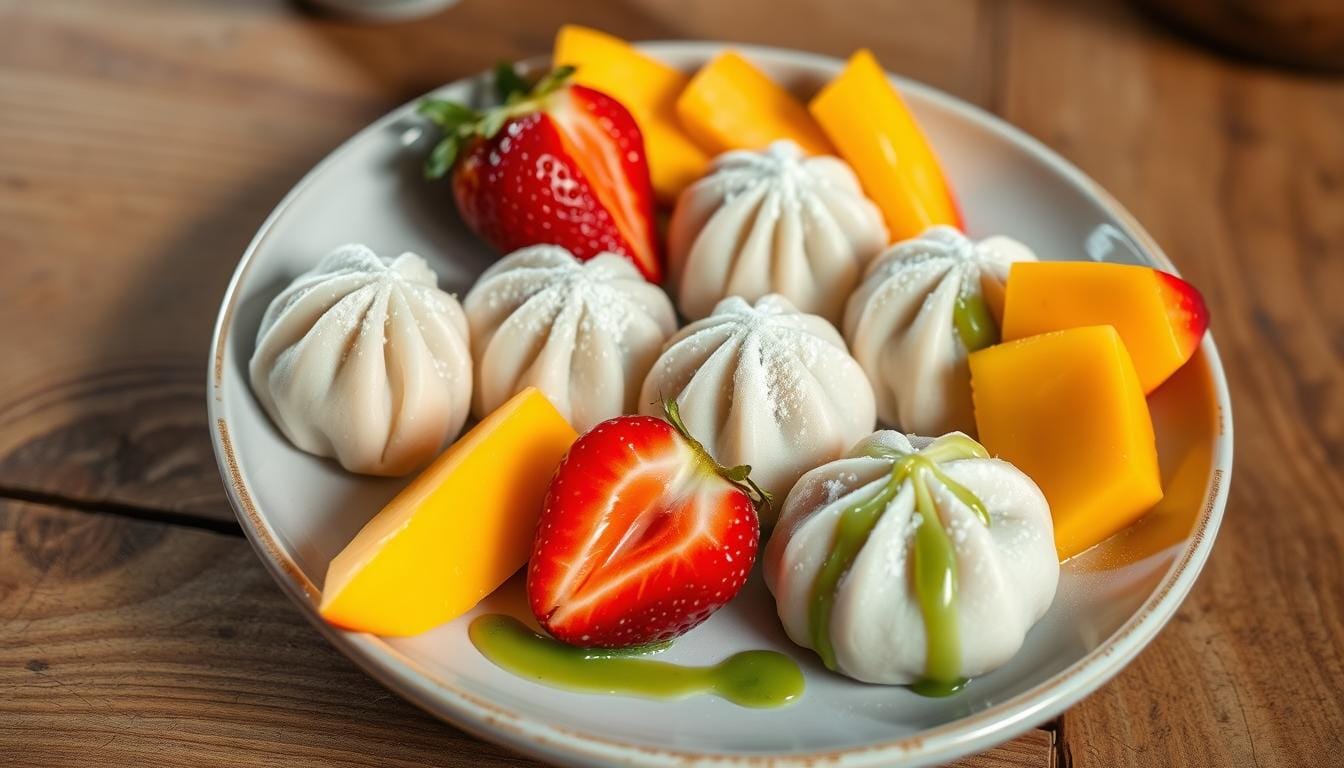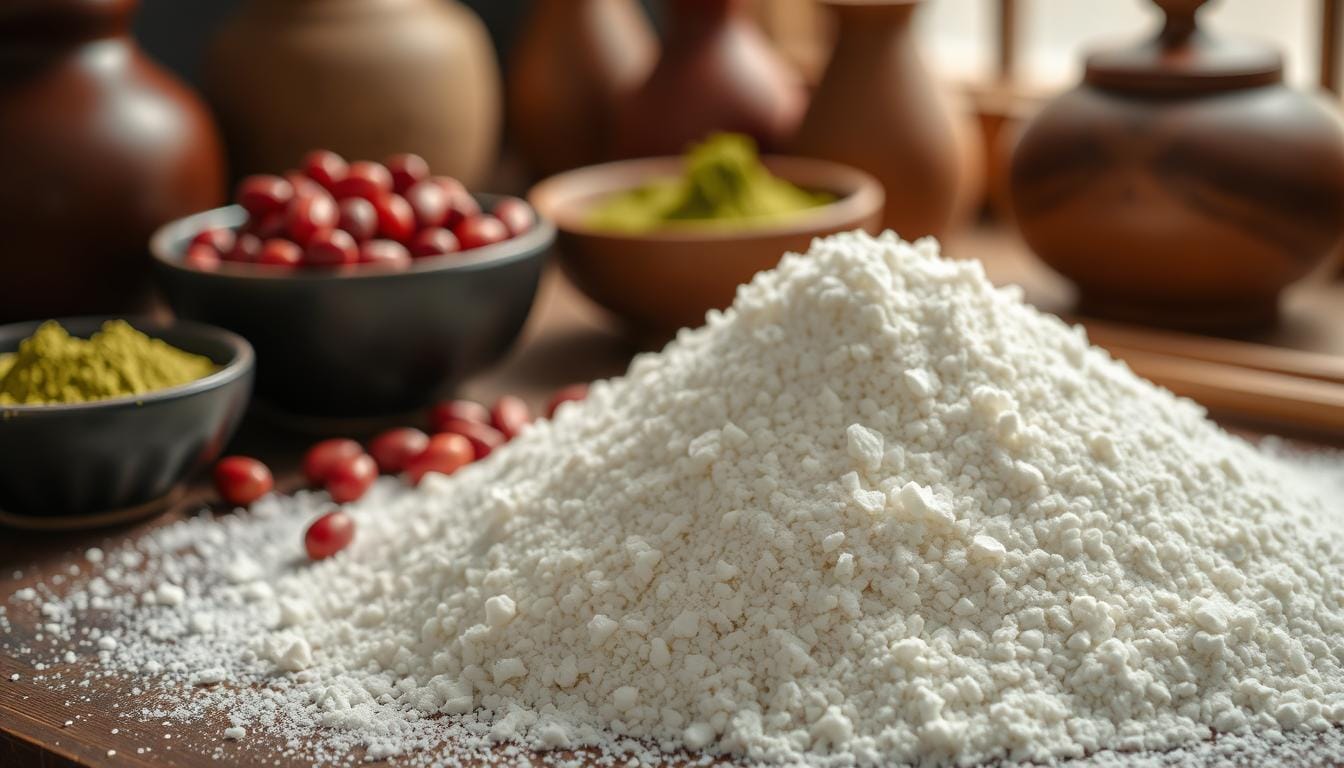I love desserts, and mochi is one of my favorites. It’s made from glutinous rice flour and is chewy and flavorful. Today, I’m excited to share a mochiko recipe that will take your taste buds on a trip to Japan.
If you love mochi or are new to Japanese sweets, this recipe is for you. It uses the best ingredients and traditional methods. You’ll make mochi that’s as good as the ones in Japan. Let’s start and learn how to make mochiko!
Table of Contents
Mochiko Recipe: The Ultimate Guide to Chewy Goodness
Mochi is a beloved Japanese confection known for its chewy texture. At its heart is mochiko, the key ingredient that gives it that chewiness. This guide will explore the secrets of mochiko and the world of mochi.
What is Mochi?
Mochi is a traditional Japanese dessert made from glutinous rice flour, also known as sweet rice flour or mochiko. This ingredient gives mochi its chewy, stretchy texture. Mochi is a cherished part of Japanese cuisine, loved for its unique mouthfeel.
Ingredients for Mochiko Desserts
Mochiko desserts include glutinous rice flour, sugar, milk, and cornstarch for dusting. These ingredients create a perfect balance of sweetness and texture. This results in the beloved traditional Japanese confections that mochi is known for.
“Mochi is a delightful treat that captivates the senses with its signature chewy texture.”
Mochiko’s unique properties make it essential in Japanese sweets. It allows for a wide variety of mochi-based delicacies. From daifuku mochi to kinako mochi, mochiko’s versatility is remarkable.
Step-by-Step Instructions for Making Mochiko Treats
Making mochiko treats at home is easy and fun. We’ll guide you through making the perfect mochiko dough. You’ll also learn how to cook these Japanese sweets in different ways.
Creating the Mochiko Dough
First, get your ingredients ready. You’ll need mochiko flour, sugar, coconut milk, eggs, butter, vanilla, and baking powder. Cream the butter and sugar for 3 minutes until fluffy.
Next, mix in the coconut milk and eggs. Then, add the dry ingredients like mochiko flour and baking powder. Keep mixing until the dough is smooth and elastic. Chill the dough in the fridge for 30 minutes to blend the flavors.
Cooking Methods for Mochiko
- Microwaving Mochi: For a quick option, microwave the dough. Divide it into 12 parts and shape into balls. Microwave on a safe plate for 2 minutes. Let it cool for 5 minutes before shaping or filling.
- Steaming Mochi: For a chewier texture, steam the dough. Put it in a steamer basket and steam for 10-15 minutes. The mochi should be translucent and stretchy. Remove it carefully and let it cool a bit before shaping or filling.
Choose your cooking method wisely. Work with the warm dough to shape and fill your mochiko treats. You can make traditional round mochi or try creative cookie shapes.
“Mochiko is the secret ingredient that gives mochi its signature chewy, elastic texture. Mastering the art of cooking mochiko is the foundation for creating delightful mochiko treats.”
Pro Tips for Perfecting Your Mochiko Recipe
Making the perfect mochiko treats is more than just a recipe. Learn the secrets to delicious mochiko with these tips. The dough should be smooth and easy to shape. To avoid sticking, dust your work area and hands with mochiko flour.
When shaping, be gentle and quick. Overworking makes mochi tough. Use a light touch to shape it into your desired form. Embrace the natural texture and imperfections for a handmade charm.
- Achieve the perfect mochiko dough consistency for easy handling
- Prevent mochi from sticking by lightly dusting surfaces with mochiko flour
- Use a gentle touch when shaping mochi to avoid overworking the dough
With these tips, you’ll make bakery-quality mochi soon. Try different shapes, fillings, and flavors for each batch. The possibilities are endless when you perfect your mochiko dough.

Mochiko Recipe Variations and Flavor Combinations
The world of mochiko treats is full of exciting variations and unique flavors. Let your creativity shine and explore the endless possibilities of this Japanese confection.
Matcha Mochiko Treats
Try adding matcha green tea to your mochiko for a new twist. The green color and subtle bitterness of matcha mix well with mochiko’s softness. Top it with powdered sugar or kinako for a stunning treat.
Fruity Mochiko Delights
Add a burst of freshness to your mochiko with fruity variations. Use seasonal fruits like strawberries, mangoes, or citrus. Mix the fruit puree or juice into the dough or use it as a filling.
Mochiko flour is very versatile, letting you try many flavor combinations and mochiko recipe variations. Whether you like matcha mochiko or fruity mochiko, there’s always something new to try. Let your creativity guide you on a flavorful journey through this beloved Japanese treat.
“Mochi is a versatile canvas that allows you to paint your culinary masterpieces with endless possibilities.”
Storing and Serving Mochiko Desserts
Making mochiko treats is fun, but storing and serving them right is key. These tips will help you enjoy your homemade mochiko to the fullest. Whether it’s for a special event or just because, you’ll love every bite.
Storing Mochiko Treats
For up to 3 days, keep your mochiko at room temperature, covered. This way, you can make it ahead of time without losing its texture or taste. If you want to keep it longer, freeze it. Frozen, wrapped mochiko stays chewy for up to a month.
Serving Mochiko Desserts
- Dust with powdered sugar for a classic, delicate finish.
- Serve alongside a sweet dipping sauce, such as caramel or chocolate, for added indulgence.
- Incorporate mochiko into other desserts, like ice cream sandwiches or parfaits, for a unique twist.
How you serve your mochiko matters. Enjoy it fresh for the best taste. Whether with friends or alone, these treats will impress.
“Mochiko is a versatile ingredient that allows for endless creativity in the kitchen. With proper storage and serving techniques, you can savor the chewy, sweet goodness of homemade mochiko desserts anytime.”
Mochiko Recipe: Gluten-Free and Vegan Options
The traditional mochiko recipe can be made gluten-free and vegan. Mochi made with gluten-free mochiko flour is perfect for those who avoid gluten. You can also use plant-based milk like almond or coconut milk to make it vegan.
To make a gluten-free mochiko filling, use 1/2 cup of glutinous rice flour. Add 2 tablespoons of cornstarch for a chewy texture. For the cookie dough, use a gluten-free flour blend to make it safe for those with mochiko dietary restrictions.
To make it vegan-friendly, choose vegan mochiko ingredients like vegan butter and aquafaba (chickpea liquid) as an egg substitute. Use coconut milk for a creamy filling and maple syrup for sweetness.
“By addressing dietary considerations, the mochiko recipe can be enjoyed by a wide range of individuals, making it an inclusive and accessible dessert.”
With a few simple changes, you can enjoy mochiko while meeting your dietary needs. Whether you’re gluten-free or vegan, mochiko flour makes it possible for everyone to enjoy this Japanese sweet treat.

The Versatility of Mochiko Flour
Mochiko flour is more than just a key ingredient in mochi desserts. It’s a versatile flour made from sweet short-grain rice. It opens up a world of possibilities for both home cooks and bakers.
Mochiko flour is great for making mochiko chicken. This Japanese dish has juicy chicken coated in a crispy, chewy batter. The flour’s stickiness and binding properties make it perfect for this.
- It’s also fantastic for making mochi donuts. The flour’s elasticity and chewiness add a delightful contrast to the fried dough.
- But it’s not just for sweets. Mochiko flour can also thicken sauces and soups. It gives them a luxurious, silky texture without using wheat-based flours.
Mochiko flour is incredibly versatile. It’s a must-have in your kitchen. Whether you’re making classic mochi desserts, trying new savory dishes, or need a gluten-free thickening agent, this flour is perfect.
“Mochiko flour is a game-changer in the kitchen, unlocking a world of culinary possibilities beyond its traditional uses.”
Cultural Significance of Mochiko in Japanese Cuisine
Mochiko, a key ingredient in Japanese mochi, is deeply rooted in the country’s culture. This sweet rice flour has been a mainstay in Japanese cooking for centuries. It’s a big part of important cultural events and traditions.
Mochi plays a big role in the Japanese New Year. It’s a key part of the osechi ryori menu, symbolizing good luck, long life, and family togetherness. Making mochi, or mochitsuki, is a shared activity during New Year’s. It shows how much mochi means to the culture.
Mochi’s importance goes beyond the New Year. Different types of mochi, like Daifuku and Sakura Mochi, celebrate the seasons and Japan’s diverse food traditions. These mochi are more than tasty treats; they represent Japan’s cultural heritage.
Recently, mochi has become popular worldwide, with mochi ice cream being a hit. These new takes on mochi show its lasting appeal and versatility. They prove that mochiko remains a favorite in Japanese cuisine and beyond.
“Mochi is not just a dessert; it’s a cultural tradition that has been woven into the fabric of Japanese life for centuries.”
Exploring mochiko and its uses reveals a rich cultural history. It shows the lasting importance of this ingredient in Japanese food culture.
Conclusion
This guide has shown you how to make tasty homemade mochiko treats. You now know the essential ingredients and how to achieve the right mochi texture. Whether you love mochiko desserts or are new to them, this recipe offers a chewy and indulgent treat.
Koda Farms, a famous mochiko flour and organic rice producer, closed after nearly 100 years. This shows how vital it is to keep traditional Japanese ingredients and methods alive. By using mochiko recipes, you can honor Japan’s culinary traditions and make your own mochi recipe wonders at home.
With this article’s help, you’re ready to start making your own homemade mochiko treats. Try different flavors and styles to bring Japanese desserts to life in your kitchen. Enjoy the chewy texture of mochiko treats and share them with loved ones, bringing a taste of Japan to your home.
FAQ
What is mochi?
What are the key ingredients in mochiko desserts?
How do you make mochiko dough?
What are some tips for perfecting mochiko recipes?
What are some creative mochiko recipe variations?
How do you store and serve mochiko desserts?
Can I make gluten-free or vegan mochiko treats?
What other ways can I use mochiko flour?
What is the cultural significance of mochiko in Japanese cuisine?

Mochiko Recipe: The Ultimate Guide to Chewy Goodness
Ingredients
- For the Mochiko Dough:
- 1 cup mochiko glutinous rice flour
- ½ cup sugar
- 1 cup coconut milk or any milk of your choice
- 2 tablespoons cornstarch for dusting
- Optional: 1 teaspoon vanilla extract
- For the Fillings Optional:
- Sweetened red bean paste
- Fresh fruits strawberries, mango, etc.
- Ice cream for mochi ice cream
Instructions
- Prepare the Dough:
- In a mixing bowl, combine the mochiko and sugar.
- Gradually add the coconut milk and vanilla extract (if using), stirring until smooth and well combined.
- Cooking the Dough:
- Microwave Method:
- Transfer the mixture to a microwave-safe bowl.
- Cover with a damp paper towel and microwave for about 2-3 minutes. Stir halfway through until the dough is thick and sticky.
- Steaming Method:
- Pour the mixture into a heatproof dish or tray lined with parchment paper.
- Steam for about 10-15 minutes until the dough is translucent and sticky.
- Cool and Shape:
- Let the mochi dough cool slightly until it’s manageable. Dust your hands and work surface with cornstarch to prevent sticking.
- Divide the dough into small portions and flatten each piece.
- If you’re using fillings, place a small amount in the center and fold the dough over to seal.
- Dust and Serve:
- Dust the finished mochi with cornstarch to prevent sticking.
- Enjoy as is, or serve with a sweet dipping sauce like chocolate or caramel.
Notes
- Storage: Keep mochi at room temperature for up to 3 days, or freeze for up to a month. If freezing, wrap each piece in plastic wrap to maintain freshness.
- Texture: The dough should be smooth and elastic. If it’s too sticky, dust with more cornstarch while shaping.

